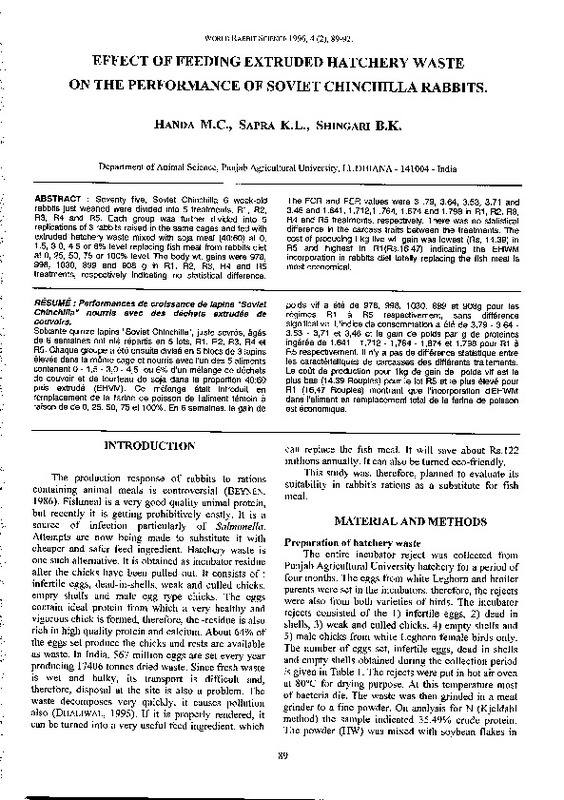JavaScript is disabled for your browser. Some features of this site may not work without it.
Buscar en RiuNet
Listar
Mi cuenta
Estadísticas
Ayuda RiuNet
Admin. UPV
EFFECT OF FEEDING EXTRUDED HATCHERY WASTE ON THE PERFORMANCE OF SOVIET CHINCHILLA RABBITS
Mostrar el registro sencillo del ítem
Ficheros en el ítem
| dc.contributor.author | Handa, M.C.
|
|
| dc.contributor.author | Sapra, K.L.
|
|
| dc.contributor.author | Shingari, B.K.
|
|
| dc.date.accessioned | 2011-03-21T12:10:17Z | |
| dc.date.available | 2011-03-21T12:10:17Z | |
| dc.date.issued | 1996 | |
| dc.identifier.issn | 1257-5011 | |
| dc.identifier.uri | http://hdl.handle.net/10251/10472 | |
| dc.description.abstract | [EN] Seventy five, Soviet Chinchilla 6 week-old rabbits just weaned were divided into 5 treatments, H1 , H2, H3, H4 and H5. Each group was further divided into 5 replications of 3 rabbits raised in the same cages and fed with extruded hatchery waste mixed with soja meal (40:60) at O, 1.5, 3.0, 4.5 or 6% level replacing fish meal from rabbits diet at O, 25, 50, 75 or 100% level. The body wt. gains were 978, 998, 1030, 899 and 908 g in H1, H2, H3, H4 and H5 treatments, respectively indicating no statistical difference. The FCH and PEH values were 3 .79, 3.64, 3.53, 3.71 and 3.46 and 1.641, 1.712,1.764,1.674 and 1.798 in H1, H2, H3, H4 and H5 treatments, respectively. There was no statistical difference in the carcass traits between the treatments. The cost of producing 1 kg live wt. gain was lowest (Hs, 14.39) in H5 and highest in H1 (Hs.16.47) indicating the EHWM incorporation in rabbits diet totally replacing the fish meal is most economical. | es_ES |
| dc.description.abstract | [FR] Soixante quinze lapins "Soviet Chinchilla", juste sevrés, agés de 6 semaines ont été répartis en 5 lots, H1, H2, H3, H4 et H5, Chaque groupe a été ensuite divisé en 5 blocs de 3 lapins élevés dans la meme cage et nourris avec l'un des 5 aliments contenant O - 1,5 - 3,0 - 4,5 ou 6% d'un mélange de déchets de couvoir et de tourteau de soja dans la proportion 40:60 puis extrudé (EHVM). Ce mélange était introduit en remplacement de la farine de poisson de l'aliment témoin a raison de de O, 25, 50, 75 et 100%. En 6 semaines, le gain de poids vif a été de 978, 998, 1030, 899 et 908g pour les régimes H1 a H5 respectivement, sans différence significative. L'indice de consommation a été de 3,79 - 3,64 - 3,53 - 3,71 et 3,46 et le gain de poids par g de proteines ingérée de 1,641 - 1,712 - 1,764 - 1,674 et 1,798 pour H1 a H5 respectivement. 11 n'y a pas de différence statistique entre les caractéristiques de carcasses des différents traitements. Le coüt de production pour 1 kg de gain de poids vif est le plus bas (14,39 Houpies) pour le lot H5 et le plus élevé pour H1 (16,47 Houpies) montrant que l'incorporation d'EHWM dans l'aliment en remplacement total de la farine de poisson est économique. | |
| dc.language | Inglés | es_ES |
| dc.publisher | World Rabbit Science. ICTA. UPV | es_ES |
| dc.relation.ispartof | World Rabbit Science | |
| dc.rights | Reserva de todos los derechos | es_ES |
| dc.title | EFFECT OF FEEDING EXTRUDED HATCHERY WASTE ON THE PERFORMANCE OF SOVIET CHINCHILLA RABBITS | es_ES |
| dc.type | Artículo | es_ES |
| dc.date.updated | 2011-03-21T11:13:13Z | |
| dc.identifier.doi | 10.4995/wrs.1996.277 | es_ES |
| dc.rights.accessRights | Abierto | es_ES |
| dc.description.bibliographicCitation | Handa, M.; Sapra, K.; Shingari, B. (1996). EFFECT OF FEEDING EXTRUDED HATCHERY WASTE ON THE PERFORMANCE OF SOVIET CHINCHILLA RABBITS. World Rabbit Science. 04(2). https://doi.org/10.4995/wrs.1996.277 | es_ES |
| dc.description.accrualMethod | SWORD | es_ES |
| dc.relation.publisherversion | https://doi.org/10.4995/wrs.1996.277 | es_ES |
| dc.description.volume | 04 | |
| dc.description.issue | 2 | |
| dc.identifier.eissn | 1989-8886 | es_ES |








